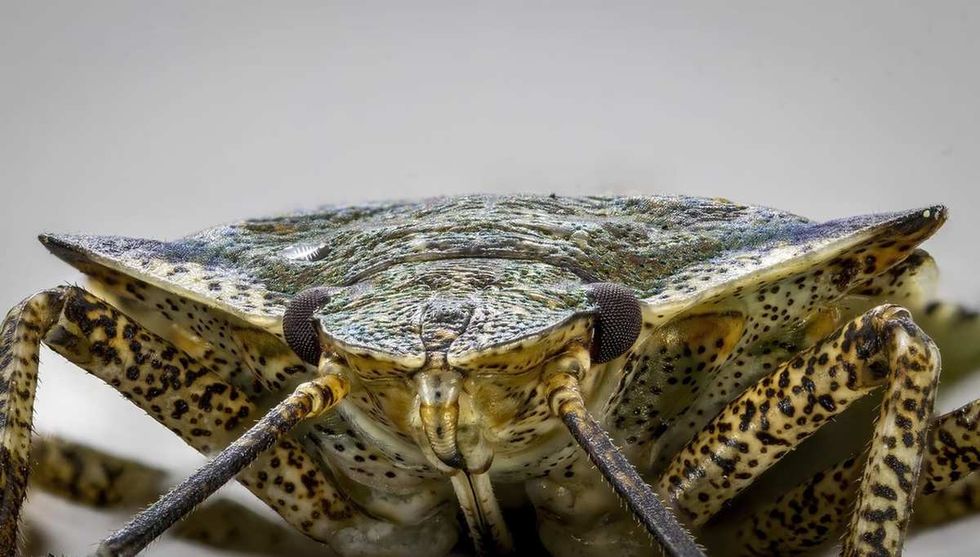Far from being ordinary insects, stink bugs have some fascinating secrets up their six-legged sleeves. So grab your magnifying glass, and let's embark on a delightful discovery together!
Stink bugs are peculiar creatures of the bug world, sporting a shield-like shape and a powerful stink to fend off predators. But don't worry, their smell is mostly a defense mechanism and won't harm you!
These colorful creatures can be found all over the world, and they live a life full of adventure. From sipping on plant juices to cozying up in large groups during cold winters, stink bugs have a unique lifestyle.
Now, stink bugs aren't just about the stink; they lead quite intricate lives. Some are farmers' foes, munching on vegetable and fruit crops, while others are beneficial buddies that help keep other pesky insects in check.
Controlling stink bugs can be quite a challenge, so farmers have to get creative and explore various pest management strategies. With over 4700 species out there, you never know what a stink bug might be up to next!
Let's explore these stink bug facts in further detail. You will also get to discover many more fascinating tidbits about the bug's features, behaviors, and threats, to learn more about the species and about insects in general.
Please note that a lot of the information and facts we have presented here are about the brown marmorated stink bug. Although we have focused on other stink bugs, due to the lack of available sources on other stink bug species, these facts cannot be generalized to all stink bug populations.
Stink Bug Interesting Facts
What type of animal is a stink bug?
Stink bugs are insects that are considered a nuisance pest. They give out an unpleasant odor.
What class of animal does a stink bug belong to?
Stink bugs belong to the class Insecta and the family Pentatomidae.
How many stink bugs are there in the world?
There are around 900 known genera and over 4,700 known stink bug species.
Where does a stink bug live?
They are found in parts of Eastern Asia, and North America. The bug has also become common in Europe and South America fairly recently.
What is a stink bug's habitat?
Adult stink bugs feed on vegetable and fruit crops so most of their population can be found in orchards, gardens, farms, and other areas with ample vegetation. Since these are solitary creatures and have a wide range of host plants, the population distribution can also be wide.
Starting from the fall, stink bugs will seek shelter within artificial structures for overwintering. As such, stink bug infestations in homes are common during winter.
Who do stink bugs live with?
The adult brown marmorated stink bug is considered a solitary insect. However, it is possible to find these bugs in clusters due to more practical reasons like, during the matings season, in overwintering sites, in feeding sites, and as groups of young or newborn nymphs.
How long does a stink bug live?
Stink bugs live for an average of six to eight months. However, under suitable environmental conditions, some stink bug species can have a lifespan of almost a year. In the cool temperate zones, the stink bugs can produce one successful generation every year. However, warmer climates can influence the production of two to six generations every year.
How do they reproduce?
The brown marmorated stink bugs become active from March through to September. The male bug courts its mate by releasing pheromones and signals in the form of vibrations.
The climate in the United States is considered ideal for the reproduction of stink bugs. Males and females mate during spring, with the female laying eggs, which develop into nymphs, and then adult stink bugs. Stink bugs don't reproduce in indoor spaces.
Female stink bugs lay eggs in clusters on the underside of leaves. The eggs are light green when fresh. The eggs eventually turn white. They typically produce one or two clusters of stink bug eggs each year in cool climates; however, they can produce up to five clusters annually in hotter climates.
What is their conservation status?
The conservation status of brown marmorated stink bugs remains unknown. It is not listed in the IUCN Red List. However, because this brown stink bug has become an invasive pest in many parts of the US, it can be speculated that its population is not under any current threat.
Stink Bug Fun Facts
What do stink bugs look like?

The brown marmorated stink bug has a dark brown upper side, while the underside is creamy and whitish-brown. Its body is somewhat triangular or shield-like in shape when viewed from above, with six legs.
The nymphs have a dark brown or black coloration. Young nymphs develop black antennae from the second stage of molting and go through a total of five stages of molting to become an adult stink bug.
All adult stink bugs have five-segmented antennae. An adult stink bug also has hindwings and forewings that lay across its back, while the bug is at rest.
The adult brown marmorated stink bug appears to have dark bands on the outer edge of its abdomen, along with bands on its antenna of a light color. Its brown legs also have faint white bands.
How cute are they?
Stink bugs are not considered to be cute by most people.
How do they communicate?
Stink bugs create mechanical vibrational signals to communicate with each other.
How big is a stink bug?
Stink bugs can grow up to 0.6-0.8 in (1.5-2 cm) in length.
How fast can stink bugs move?
They can move very fast for small bugs, however, the exact speed cannot be determined.
How much does a stink bug weigh?
Stink bugs are tiny creatures, and weigh about 0.0039-0.0043 oz (111–123 mg).
What are the male and female names of the species?
There are many species of stink bugs, with more than 200 species in North America alone. The scientific name of brown marmorated stink bugs is Halyomorpha halys. Another common species is the Chinavia hilaris or green stink bug. The male and female bugs do not have different names.
What would you call a baby stink bug?
The babies of stink bugs are called nymphs.
What do they eat?
Stink bugs feed mainly on different fruit vegetable crops like apples, peaches, cherries, raspberries, pears, soybeans, peppers, green beans, sweet corn, eggplant, tomatoes, and many ornamental plants. Some stink bug feeding habits may differ. Few species of stink bugs are known to be predatory, like the bugs within the subfamily Asopinae.
Are they harmful?
Stink bugs are considered a pest species and a threat to the agriculture industry, especially in the US where the infestation of the brown marmorated bugs caused major economic damage. They damage plenty of fruit and vegetable crops.
It is estimated that the brown marmorated stink bug (BMSB) can feed on around 100-150 different plant species in the US, damaging the fruits, seeds, leaves, stems, and buds of the plant.
Stink bugs become a nuisance for humans during the fall and winter seasons when it migrates to homes and buildings for overwintering. The body fluids of stink bugs can irritate human skin and eyes.
Would they make a good pet?
Stink bugs would not be considered to be good pets as they have a strong odor which is not pleasant to be around.
Did You Know...
Brown marmorated stink bugs are native to Asia and were accidentally introduced in the US sometime during the late 20th century. It is considered an invasive species and an agricultural pest because the stink bug population has rapidly spread across the US, further increasing cases of agricultural damage.
The brown marmorated stinks bugs were first detected in the US in 1996. Later on, the bug was detected in Europe in 2004.
Why are they called stink bugs?
The term 'stink bug' is an American English name, specifically for the bugs within the Pentatomidade family of insects. The name is a reference to the unpleasant odor released from the holes in the abdomen of these bugs.
Whenever a stink bug feels the threat of predators or is disturbed, it releases this pungent spray as a defense mechanism. Accidentally or purposely crushing the insect will also release this odor.
It is important to note that the term 'stink bugs' can also be associated with other kinds of insects, which is unrelated to the bugs we are talking about here.
How to get rid of stink bugs?
To get rid of stink bugs, first, start by analyzing all possible entry points in your home and fix any small openings in the house. Sealing cracks in windows, doors, utility pipes, chimneys, and outlets can also be an effective preventive measure.
House maintenance during the fall is best to prevent or reduce stink bug infestation in homes since the bugs are looking for overwintering sites during that season.
They crawl into houses to protect themselves from the cold weather outdoors. For any stink bug in the house, you can install sticky traps in corners and enclosed areas to catch the bugs and later release them outside.
Avoid crushing them or using a vacuum cleaner to get rid of this invasive species of bugs to avoid spreading the unpleasant odor inside your house.
You can also call in a pest control professional during the late summer or fall to treat your home for stink bug infestation. Chemical control within homes should be avoided.
The key threat of stink bugs is however related to them being a major agricultural pest. Many stink bug species are also resistant to several pesticides, requiring different control measures to prevent crop damage.
Many insecticides are also ineffective, while most are used for keeping the bugs away from crop fields instead of killing them. One of the best methods for controlling stink bug feeding in crop fields seems to be through the introduction of predators like birds, wasps, and spiders.
More focused efforts from the state and national governments can also help in curbing stink bug infestations.
Investments and research in biological control programs can influence the development of new control measures. While there are few effective pesticides used to get rid of stink bugs, it is important to note that pesticides are poisonous and must be handled with care.
So there you have it, fellow bug enthusiasts – the wild and wonderful world of stink bugs, all wrapped up in a neat little package! While they might be a bit pesky in the garden, they're also a part of our vibrant ecosystem, each with their unique role to play.
Remember, if these little shielded adventurers find their way into your home, a gentle guide back to nature is all they need.
Whether they're nibbling on plants or helping to keep other insects at bay, stink bugs are out there living their best bug lives. Now, why not head out and discover some more of the tiny wonders in your backyard?










